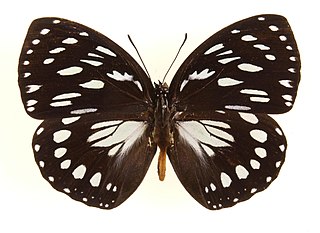Related Research Articles

Burramys is a genus of the family Burramyidae, and is represented by one living and 3 extinct (fossil) species. It is one of two genera of pygmy possum, the other being Cercartetus.

Euxanthe is a genus of butterflies in the subfamily Charaxinae.
Warendja is an extinct genus of marsupial, present from the Late Miocene to the Late Pleistocene, which went extinct in the Quaternary extinction event. Weighing 10 kg, Warendja is the earliest known vombatiforme to exhibit hypsodonty.

Stephan von Breuning was an Austrian entomologist who specialised in the study of beetles (Coleopterology), particularly within the longhorn family (Cerambycidae).
Cystiscus wakefieldi is a species of very small sea snail, a marine gastropod mollusk or micromollusk in the family Cystiscidae.

Euxanthe wakefieldi, the forest queen, is a butterfly of the family Nymphalidae. It is found in South Africa, from KwaZulu-Natal to Swaziland and the north-eastern Limpopo, north into eastern Africa. The wingspan is 65–72 mm for males and 80–90 mm for females. Adults are on wing year round, with a peak from March to June. The larvae feed on Deinbollia species, Sapindus, Blighia, and Phialodiscus species. They are notable for their spectacular horns.

Phanodesta wakefieldi is a beetle of the family Trogossitidae, endemic to New Zealand. It was originally named Leperina wakefieldi, and has also been referred to as Lepidopteryx wakefieldi.

Pogonocherini is a tribe of longhorn beetles of the subfamily Lamiinae.

Hybolasius is a genus of longhorn beetles of the subfamily Lamiinae, containing the following species:
Hybolasius dubius is a species of beetle in the family Cerambycidae. It was described by Broun in 1893. It is known from New Zealand.
Hybolasius femoralis is a species of beetle in the family Cerambycidae. It was described by Broun in 1893. It is known from New Zealand.
Hybolasius genalis is a species of beetle in the family Cerambycidae. It was described by Broun in 1903. It is known from New Zealand. It contains the varietas Hybolasius genalis var. tumidellus.
Hybolasius modestus is a species of beetle in the family Cerambycidae. It was described by Broun in 1880. It is known from New Zealand.
Hybolasius parvus is a species of beetle in the family Cerambycidae. It was described by Broun in 1880. It is known from New Zealand. It contains the varietas Hybolasius parvus var. pusillus.
Hybolasius promissus is a species of beetle in the family Cerambycidae. It was described by Broun in 1880. It is known from New Zealand.

Hybolasius crista is a species of beetle in the family Cerambycidae. It was described by Johan Christian Fabricius in 1775. It is known from New Zealand.
Hybolasius cristatellus is a species of beetle in the family Cerambycidae. It was described by Henry Walter Bates in 1876. It is known from New Zealand.
Hybolasius lanipes is a species of beetle in the family Cerambycidae. It was described by Sharp in 1877. It is known from New Zealand.
Hybolasius modestior is a species of beetle in the family Cerambycidae. It was described by Stephan von Breuning in 1940. It is known from New Zealand.
Hybolasius sinuatofasciatus is a species of beetle in the family Cerambycidae. It was described by Stephan von Breuning in 1940. It is known from New Zealand.
References
- ↑ BioLib.cz - Hybolasius wakefieldi. Retrieved on 8 September 2014.